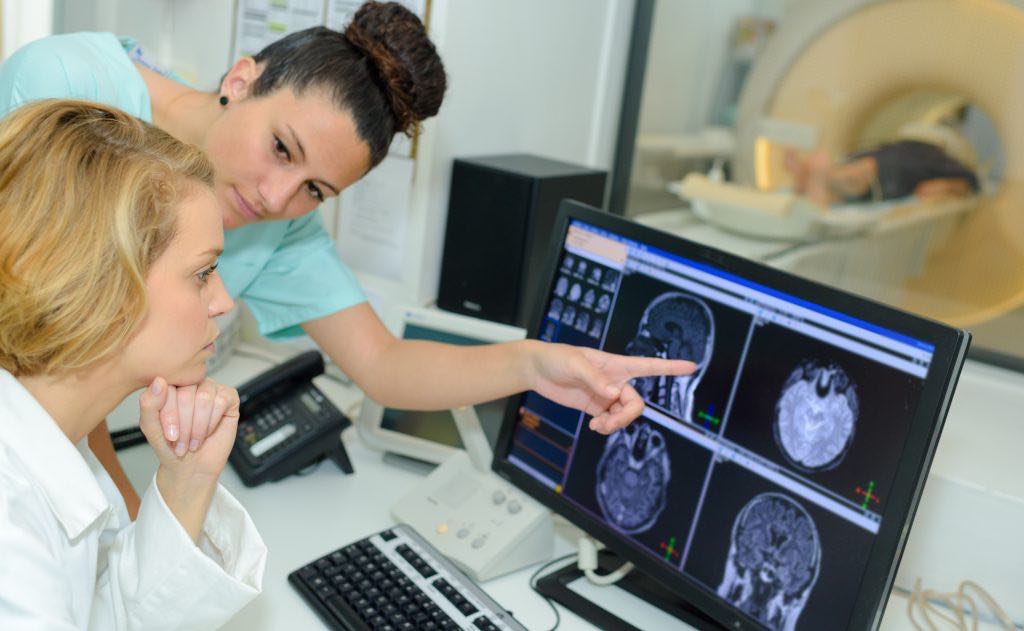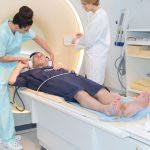Magnetic resonance imaging (MRI) is a technology that uses radio waves and magnetic fields to create images of the body’s internal structures and tissues. This diagnostic imaging test allows your physician to gain insight into the condition of your internal organs without subjecting you to the ionizing radiation present in x-rays. MRI waves pass through bone and allow your physician to see the organs, tendons and soft tissues underneath. The images, or scans, taken by the MRI machine are three-dimensional and are displayed on a computer screen.
Sometimes, MRI technology can be used to examine certain blood vessels. This procedure is called a magnetic resonance angiography (MRA). This allows your physician to diagnose and monitor any conditions that affect your blood flow. An MRA may be performed at the same time as an MRI, or it may be performed on its own. Both scans are generally safe, non-invasive procedures. Below, learn some of the key similarities and differences between the two procedures so that you know what to expect for your specific situation.
MRI vs. MRA: uses
MRI scans are used to diagnose and monitor a variety of conditions that affect the soft tissues inside your body. These include:
- Ligament or tendon injury
- Multiple sclerosis
- Eye or inner ear disorders
- Spinal cord injury
- Brain conditions or tumors
- Bone and joint disorders or tumors
- Heart disease or structural problems in the aorta
- Tumors or cancer in internal organs
MRA scans focus on the function of your body’s blood vessels (arteries and veins) in your brain, neck, chest, and abdomen. These scans can be used to detect and evaluate:
- Aneurysms and blood clots
- Calcium deposits
- The effects of a stroke
- Narrowing blood vessels
- Injury to the arteries or veins
MRI vs. MRA: preparation
For most MRIs, you will not be asked to make any special preparations. On the day of your procedure, you should be able to eat and drink normally, as well as take your normal medications, unless your doctor tells you otherwise.
For an MRA, preparation instructions can vary by facility. Unless you are given specific guidelines, you should be able to eat and drink normally before your procedure. If you are unsure, contact your physician.
If the area being scanned is above your shoulders, you should avoid wearing any jewelry or make-up. Keeping your hair free of hairpins and hairspray or gel is also recommended, as these may affect your scan.
You should plan on arriving around thirty minutes early to your scan to register and change into a hospital gown, if required. You will be asked to remove all jewelry and metal clothing, as these will respond to the powerful magnets in the MRI machine.
MRI vs. MRA: contrast materials
Depending on the reason for your MRI or MRA, you may need to take contrast materials before your scan. Contrast dyes are a safe drug that is typically administered orally or through an IV. However, you should talk with your doctor about any allergies, especially to shellfish or iodine, before you take your contrast agent. The material may make you feel warm or flushed, but severe allergic reactions are very rare. If you are concerned, don’t hesitate to talk to your technologist. They are trained and equipped to deal quickly with any adverse reactions.
MRI vs. MRA: procedure
MRA and MRI scans are made using the same machine, resembling a small tunnel with openings at both ends. You will be on a small bed that slides into the machine during your scan. Talk to you doctor in advance if you suffer from claustrophobia or PTSD, as they may prescribe medication for your anxiety.
During the scan, you must lie as still as possible to allow the machine to take clear images. The MRI machine may make loud knocking noises as it scans, so patients typically wear earplugs or headphones to protect their ears.
The technologist will be in a separate room with a large window that overlooks the MRI machine. They will be able to see you and communicate with you throughout the entire procedure. Most exams take thirty minutes to two hours. If it is painful for you to lie still for that long, your doctor may prescribe a sedative for you to take before the procedure.
Following your scan, a radiologist will interpret the images taken during the MRI or MRA and send the results to your physician. Your doctor will call you to discuss their findings and your potential treatment options. A follow-up MRI or MRA may be recommended to continue monitoring an abnormality or to assess the success of any treatments.
Need an MRI or an MRA?
In many cases, an MRI or MRA can provide your physician with information that an x-ray or CT scan is unable to capture. Don’t let worry about the high costs associated with these procedures keep you from scheduling your scan. New Choice Health can help you compare healthcare facilities in your area to find the option that works best for you. Use New Choice Health’s cost comparison tool to find the best price for your MRI or MRA today.







